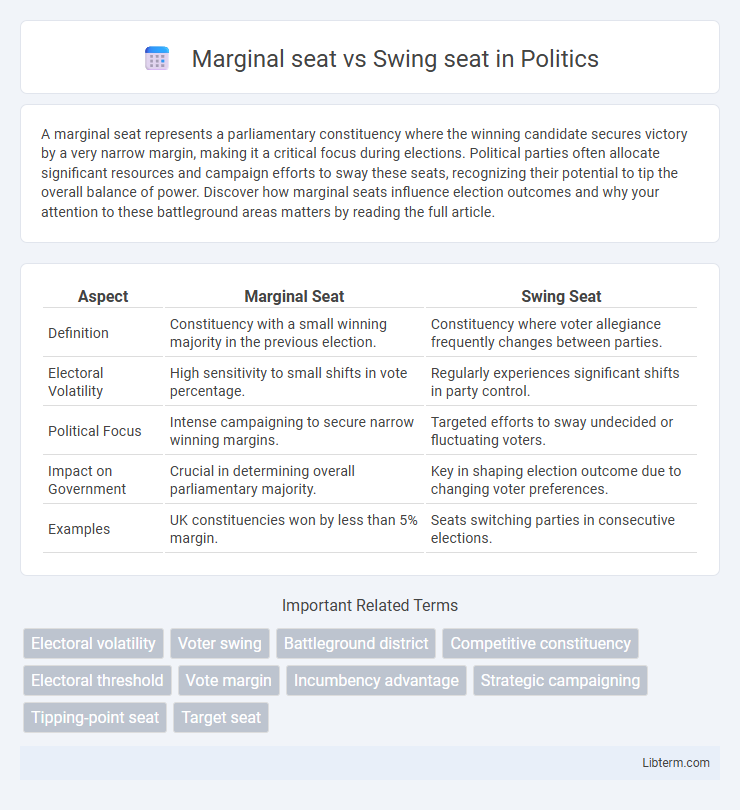A marginal seat represents a parliamentary constituency where the winning candidate secures victory by a very narrow margin, making it a critical focus during elections. Political parties often allocate significant resources and campaign efforts to sway these seats, recognizing their potential to tip the overall balance of power. Discover how marginal seats influence election outcomes and why your attention to these battleground areas matters by reading the full article.
Table of Comparison
| Aspect | Marginal Seat | Swing Seat |
|---|---|---|
| Definition | Constituency with a small winning majority in the previous election. | Constituency where voter allegiance frequently changes between parties. |
| Electoral Volatility | High sensitivity to small shifts in vote percentage. | Regularly experiences significant shifts in party control. |
| Political Focus | Intense campaigning to secure narrow winning margins. | Targeted efforts to sway undecided or fluctuating voters. |
| Impact on Government | Crucial in determining overall parliamentary majority. | Key in shaping election outcome due to changing voter preferences. |
| Examples | UK constituencies won by less than 5% margin. | Seats switching parties in consecutive elections. |
Understanding Marginal Seats: Definition and Importance
Marginal seats are electoral districts where the winning candidate's majority is very small, often less than 5% of the vote, making them highly competitive and crucial for determining election outcomes. These seats attract significant attention from political parties because small voter shifts can change the winning party, influencing overall parliamentary control. Understanding marginal seats helps explain campaign strategies, resource allocation, and the dynamics of closely contested elections.
What Are Swing Seats? Key Characteristics
Swing seats are electoral districts where no single party holds a dominant majority, making them highly competitive and pivotal in determining election outcomes. These seats often experience fluctuating voter allegiance, with margins of victory typically below 5%, reflecting their volatility and importance in parliamentary systems. Demographic diversity and shifting political preferences characterize swing seats, requiring targeted campaign strategies to capture undecided or swing voters.
Marginal Seats vs. Swing Seats: Core Differences
Marginal seats are electoral districts where the incumbent wins by a small but consistent margin, indicating a relatively stable yet competitive voter base, while swing seats are constituencies that frequently change party allegiance, reflecting higher electoral volatility. The core difference lies in voter behavior predictability, with marginal seats showing slight preference trends and swing seats marked by fluctuating voter support due to changing political dynamics or campaign influence. Understanding these distinctions is crucial for political strategists targeting resource allocation, as marginal seats offer incremental gains whereas swing seats present opportunities for major shifts in parliamentary representation.
Historical Context: Evolution of Key Seats in Elections
Marginal seats, characterized by narrow victory margins, have historically shaped electoral strategies due to their unpredictability and high impact on overall election results. Swing seats, which frequently change party allegiance, evolved as crucial battlegrounds reflecting shifting voter sentiments and demographic changes over time. The evolution of these key seats traces the dynamic nature of political competition, influencing campaign resource allocation and party focus throughout election history.
The Role of Marginal and Swing Seats in Election Outcomes
Marginal seats, defined by narrow victory margins, and swing seats, which frequently change party control, play a pivotal role in determining election outcomes by often deciding the overall winner. These constituencies attract significant campaign resources as parties target undecided voters to secure crucial vote shares. The strategic importance of marginal and swing seats lies in their potential to shift power balances in closely contested elections, making them key battlegrounds for political campaigns.
How Parties Target Marginal and Swing Seats
Political parties allocate significant resources to marginal and swing seats due to their potential to sway election outcomes. Campaign strategies often include tailored messaging, increased canvassing, and targeted advertising in these constituencies to maximize voter persuasion and turnout. Data analytics and voter demographics guide parties in prioritizing these key battleground areas over safe seats where outcomes are more predictable.
Voter Behavior in Marginal and Swing Seats
Voter behavior in marginal and swing seats is characterized by heightened electoral sensitivity due to the close competition between parties. In marginal seats, voters tend to be more influenced by targeted campaign messages, local issues, and candidate appeal, as the outcome often hinges on small shifts in voter preference. Swing seat electorates demonstrate fluctuating loyalty, frequently shifting party support based on recent political performance, policy changes, and national trends, making these constituencies critical battlegrounds during elections.
Case Studies: Notable Marginal and Swing Seats
Notable marginal seats such as Wigan in the UK have consistently demonstrated tight electoral contests, where a few hundred votes decide the winner, influencing national policy directions. Swing seats like Ohio's 16th Congressional District in the US regularly shift party control, making them critical battlegrounds in presidential and midterm elections. Case studies highlight how targeted campaign strategies and demographic changes in these seats significantly impact overall election outcomes and political power balance.
Strategies for Winning Marginal vs. Swing Seats
Winning marginal seats requires targeted voter outreach and focused local campaigning to sway a small but critical number of undecided voters. Campaigns prioritize personalized messaging, grassroots mobilization, and addressing specific local issues to maximize vote margins in marginal constituencies. In contrast, strategies for swing seats emphasize broad appeal, coalition-building, and adapting party platforms to resonate with diverse voter groups that can tip overall election outcomes.
The Future Impact of Marginal and Swing Seats on Politics
Marginal seats and swing seats hold significant influence in shaping future political landscapes by determining party dominance in closely contested regions. These seats often dictate election outcomes due to their unpredictable voter behavior and narrow victory margins, driving targeted campaign strategies and resource allocation. As demographic shifts and voter realignments continue, the evolving importance of marginal and swing seats will increasingly impact policy priorities and political stability.
Marginal seat Infographic

 libterm.com
libterm.com